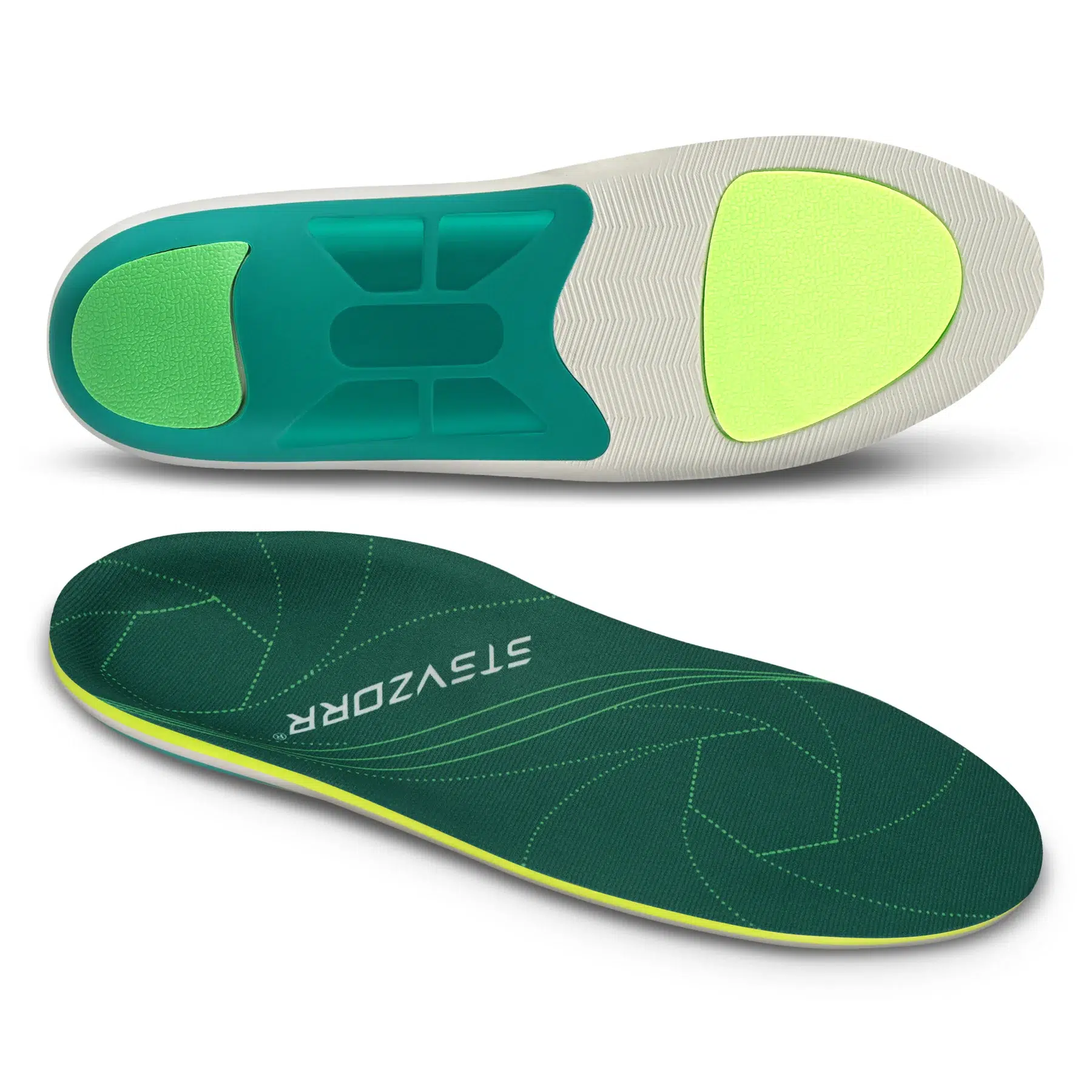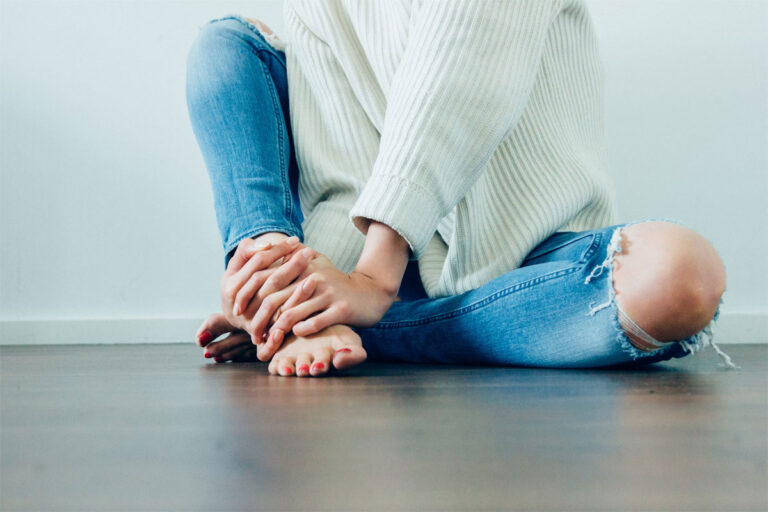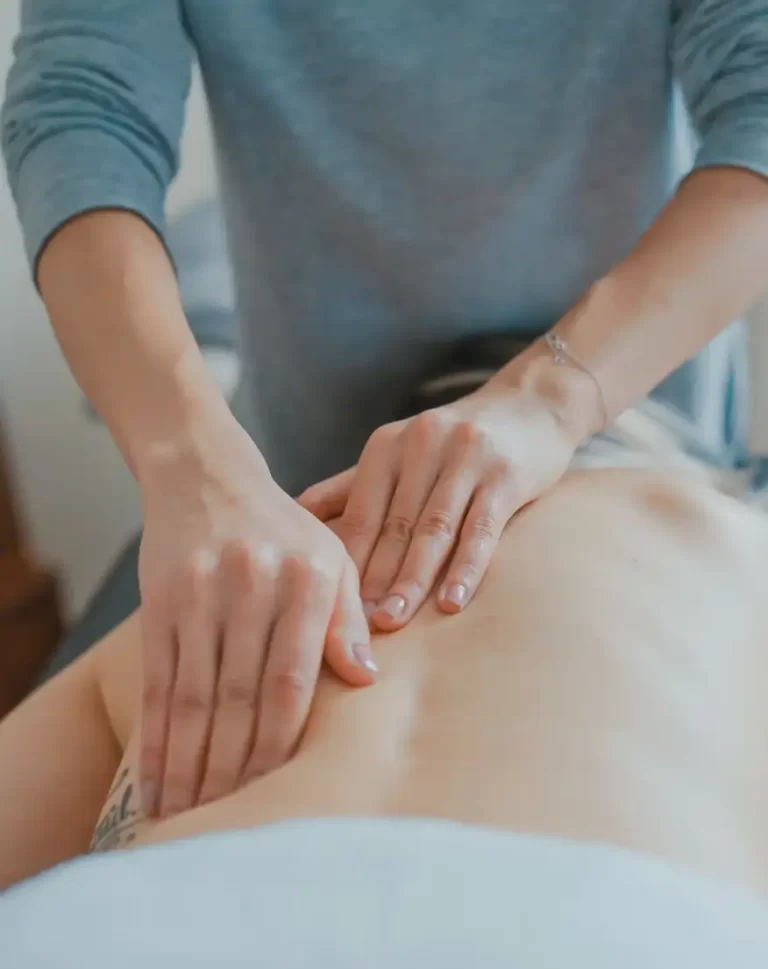Best Insoles for Sciatica Relief – Top Rated Picks for 2024
Struggling with sciatica’s pain is tough. It can really slow you down. But, don’t lose hope. The right insoles can make a huge difference. They helped me get back on my feet. Now, I want to help you find that relief.
This guide covers the best insoles for sciatica relief in 2024. Sciatica brings overwhelming back and leg pain. But, the right insoles offer true relief. We will talk about what makes a great insole for sciatica. Then, I’ll show you our top picks. Together, we can find the best insoles to make life pain-free again.
Key Takeaways
- Sciatica can cause debilitating lower back and leg pain, but the right insoles can provide relief.
- We’ll cover the key features to look for in insoles for sciatica, including arch support, shock absorption, and improved posture.
- Our top-rated picks for the best insoles in 2024 will help you find the perfect pair to alleviate your symptoms.
- Insoles can be a game-changer in managing sciatica, especially when combined with other treatments.
- Proper fit and maintenance of your insoles are crucial for ensuring long-lasting comfort and support.
Understanding Sciatica and Its Impact
Sciatica is a source of nerve pain beginning in the lower back and moving down the leg. It brings sharp, burning pain, along with numbness, tingling, and muscle weakness. Knowing about this condition and what causes it helps in finding relief.
What Is Sciatica?
Sciatica involves the sciatic nerve, the human body’s longest and widest nerve. It moves through the lower back, hips, and buttocks, into each leg. This nerve is vital for lower limb sensation and movement.
Symptoms of Sciatica
Sciatica’s main symptom is pain along the sciatic nerve’s path. It’s often sharp or burning. People might also feel numbness, tingling, and muscle weakness in one leg. The pain’s level and position can change based on what’s causing it.
Causes of Sciatica Pain
A herniated or bulging disc in the spine is a frequent cause. It presses on the nerve. Other issues like spinal stenosis, piriformis syndrome (tight buttock muscle), poor posture, injury, and aging also lead to sciatica. It’s important to know what’s causing someone’s sciatica to treat it effectively.
The Importance of Proper Footwear for Sciatica Relief
Wearing the right footwear is crucial for dealing with sciatica pain. Shoes without good arch support, cushioning, and shock absorption can hurt your posture. They worsen symptoms of sciatica. It doesn’t matter if you’re using running shoes or casual shoes. Or even if you’re wearing hiking boots. It’s vital to pick shoes that fit well and offer support tailored to your feet.
By picking the right footwear, you can reduce pressure on your sciatic nerve. This lowers back and leg pain. It also improves your posture and alignment. Better posture leads to more comfort and better mobility. It makes your day more pleasant. This is true whether you’re walking in high heels, running, or hiking.
Remember, key features in the best footwear for sciatica relief include arch support, shock absorption, and cushioning. Investing in the right shoes or insoles can really help. It’s a big step towards managing your sciatica symptoms. It also helps you get back to enjoying life more.
How Insoles Can Help Alleviate Sciatica Pain
Insoles can really help with sciatica pain. They offer targeted arch support, relieving pressure on the sciatic nerve. This eases lower back and leg pain. Also, good insoles absorb shock, reducing stress on your feet.
Providing Arch Support
Arch support is key for those with sciatica. It helps keep the spine and lower body aligned. This stops overpronation or supination, which adds to sciatica pain. Good insoles also aid in improving posture and alignment, easing sciatic nerve pressure.
Shock Absorption
The cushioning and shock absorption in insoles is crucial. They lessen the impact and movement your feet feel. This drops foot fatigue and sciatic nerve pressure. Thus, making life easier for sciatica sufferers.
Improving Posture and Alignment
Insoles stabilize your feet and promote posture and alignment. This greatly reduces sciatica symptoms. Neutral position for spine, hips, and legs cuts sciatic nerve strain. It brings decreased back pain and better mobility.
Best Insoles for Sciatica Relief
We’ve done our homework and have the top picks for sciatica relief in 2024.
ComfortMax: Flat Feet Insoles for Long-Lasting Pain Relief
The ComfortMax Flat Feet Insoles give top-notch arch support and cushioning. They use shock absorption tech. This helps ease sciatica pain and keeps you comfy all day.
- The arch support improves foot and leg alignment, enhancing comfort and helping to ease stress and discomfort caused by flat feet, bunions, arthritis, and other conditions.
- The deep heel cup maintains correct foot positioning, protects your heel during heavy impacts, and stabilizes the foot.
- The premium EVA material is excellent for shock absorption and foot fatigue, and the fabric helps keep your feet cool.
Cons
- Some users may find the insoles too thick for certain shoes.
- The blue color may not be to everyone’s liking.
- The insoles may take some time to get used to.
We found that the ComfortMax Flat Feet insoles provided excellent support and cushioning for all types of leisure or everyday footwear. They are also designed for everyday use, providing moderate control and support in walking or casual hiking shoes, work shoes, and boots.
The insoles come with a risk-free guarantee, and if you are not satisfied, you can contact customer service for a reasonable and acceptable solution.
Dr. Scholl’s ® Prevent Pain Lower Body Protective Insoles
Dr. Scholl’s ® made these insoles to fight lower body pain, like sciatica. They aim at your arch support and are cushy. They cut down on sciatic nerve pressure and better your lower body’s line.
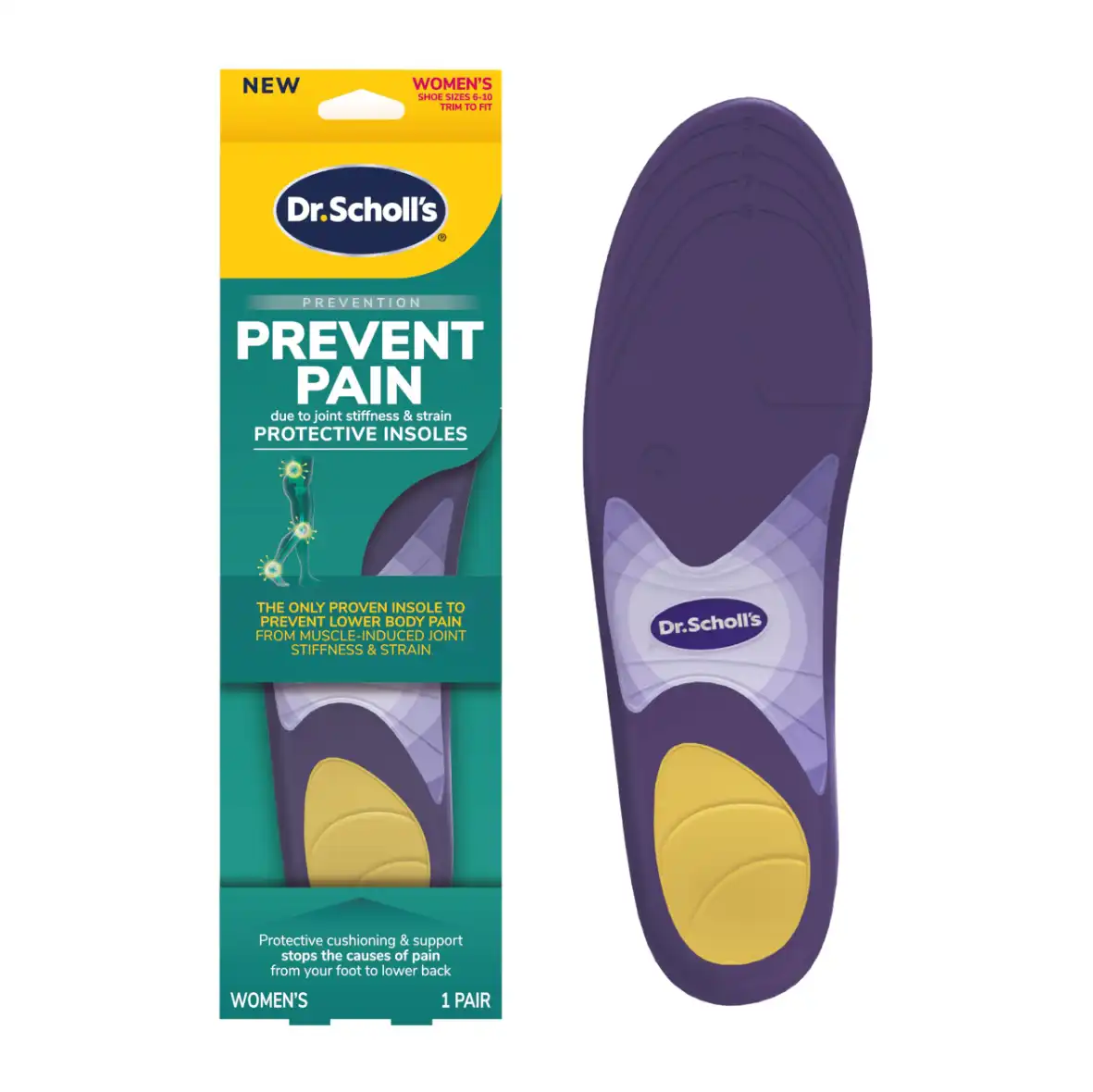
Pros
- The Tri-Protect SystemTM stops the cause of lower body pain before it occurs
- Full foot combination of cushioning, support and shock absorption defends against the muscle co-contraction that leads to lower body joint pain
- The shock absorbing heel manages stress beginning with the heel
Cons
- The position of the heel and arch are rigidly set and cannot be adjusted
- May not provide relief for severe or chronic pain
- May take some time to adjust to the insoles
We found the Dr. Scholl’s ® Prevent Pain Lower Body Protective Insoles to be extremely effective in preventing and reducing lower body joint pain. The Tri-Protect SystemTM provides a full foot combination of cushioning, support and shock absorption that defends against the muscle co-contraction that leads to lower body joint pain. The shock absorbing heel manages stress beginning with the heel, which greatly reduces the impact on the rest of the foot and lower body.
WALK·HERO COMFORT AND SUPPORT Insoles
WALK·HERO’s insoles are well-liked for good arch support, shock absorption, and comfort. They’re made with top materials. Perfect for those with sciatica.
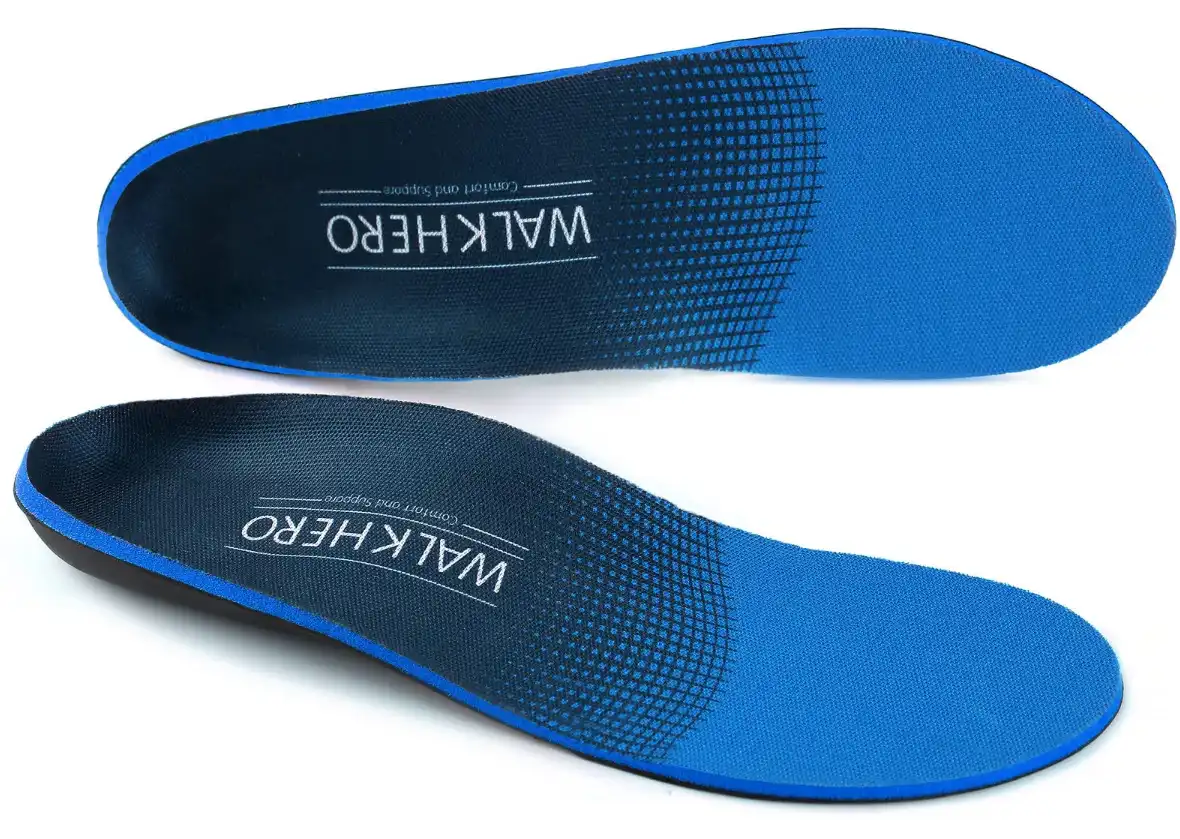
Pros
- The arch support helps improve foot and leg alignment and provides lasting comfort.
- The deep heel cup helps maintain correct foot positioning and protects your heel during impact.
- The premium EVA material provides excellent shock absorption and helps reduce foot fatigue.
Cons
- Some users may find the high arch uncomfortable.
- The insoles may not fit all shoe types.
- The blue color may not be appealing to everyone.
The WALK·HERO COMFORT AND SUPPORT Insoles to be a well-designed and effective solution for foot pain and discomfort. The arch support and deep heel cup provide excellent support and stability, while the premium EVA material helps reduce foot fatigue. However, some users may find the high arch uncomfortable, and the insoles may not fit all shoe types. Overall, we recommend these insoles for anyone looking for a comfortable and supportive solution to foot pain and discomfort.
VALSOLE Heavy Duty Support Pain Relief Orthotics
The VALSOLE orthotics give maximum support and ease for sciatica. They have best-in-class cushioning and arch support. This helps lower sciatic nerve pressure and boosts foot and lower body comfort.
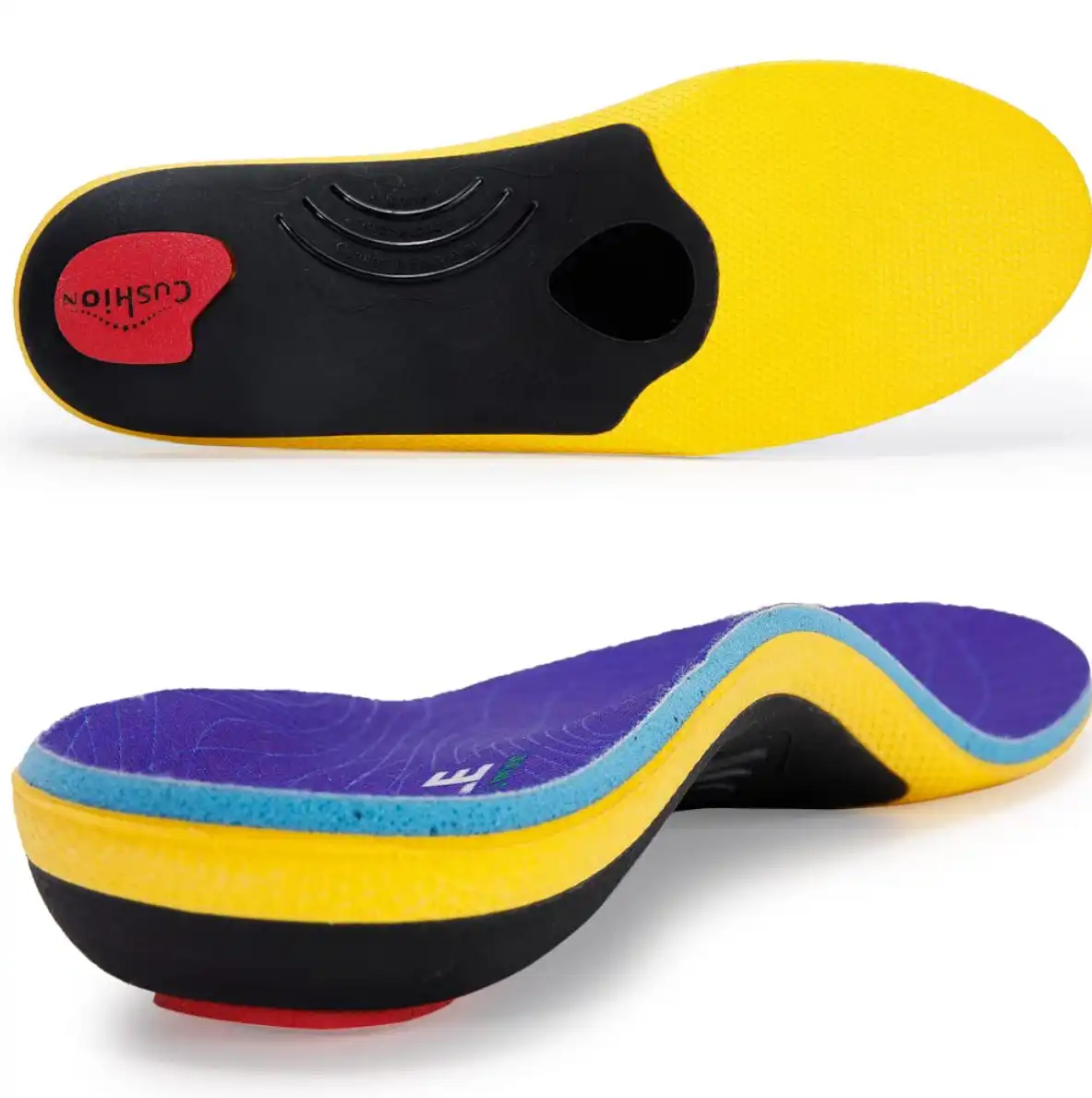
Pros
- Provides extra strong high arch support and shock guard technology to relieve foot and leg fatigue
- Helps ease stress and pain caused by flat feet, fallen arches, bunions, low back pain, and diabetes
- Poron heel pad offers excellent shock absorption and pain relief
Cons
- May not fit properly in some shoes, requiring trimming
- May cause discomfort for those with narrow feet or low arches
- May not be suitable for those weighing less than 220lbs
These insoles are designed for daily use and are adaptable for work boots, running shoes, and hiking shoes. The VALSOLE metatarsal pain insole adjusts the body by supporting subtalar joints to prevent excessive valgus or supine. The super high arch support and deep heel cup structure support with maximum cushioning keep the foot bones vertical and balanced, providing stability.
The black hard TPU material supports the arch of your foot and wraps your heel when you’re running or jogging. The good fabric reduces odor and keeps the feet fresh. These insoles provide moderate control and support in walking or sports shoes, work shoes and boots. The insoles may need trimming to fit better in your shoes.
CRUVHEAL Orthotic Shoe Inserts
The CRUVHEAL Orthotic Shoe Inserts offer great support for sciatica. They have solid arch support, absorb shock well, and have comfy cushioning. This can lessen pain and improve how your feet and lower body align.
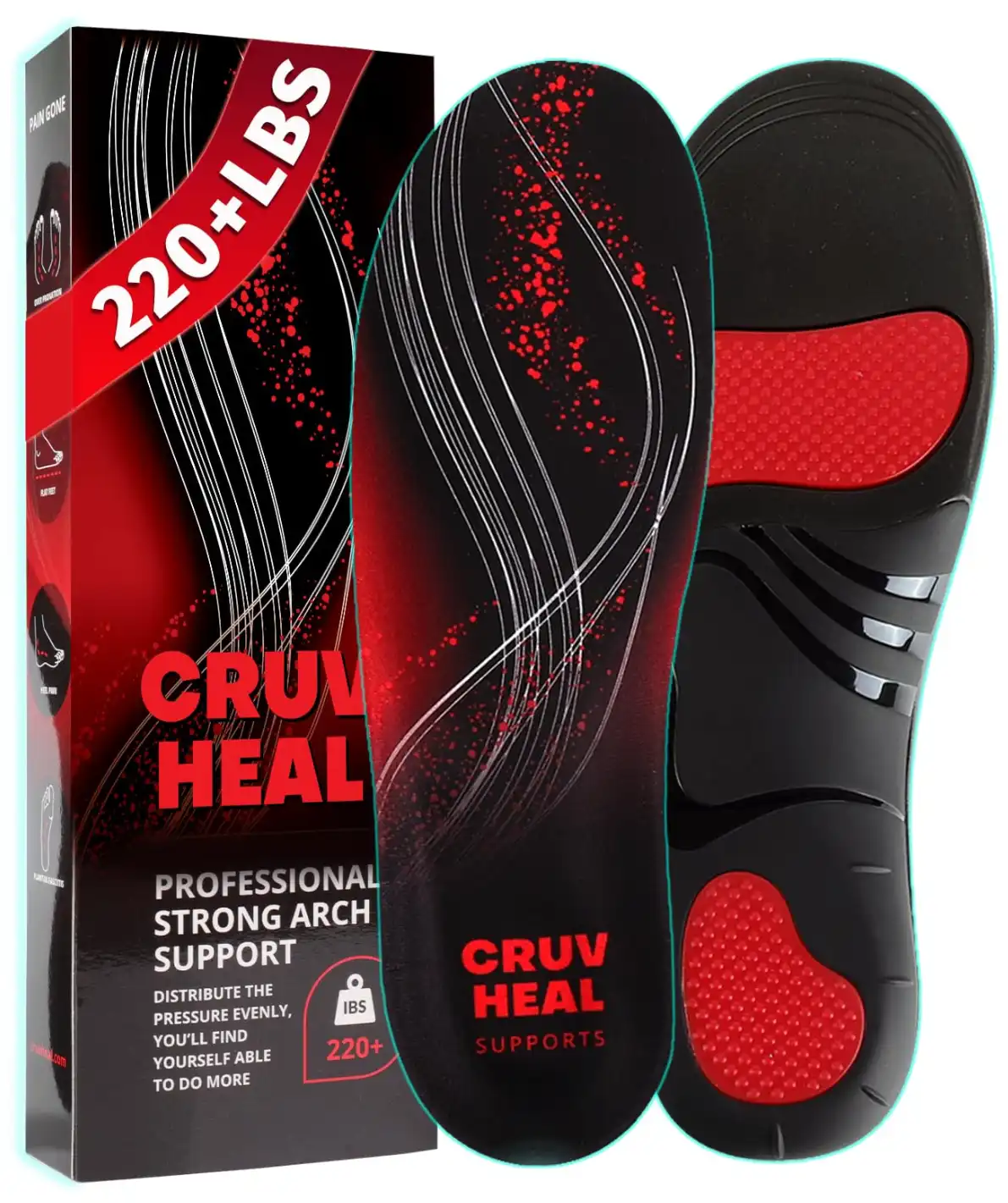
Pros
- Provides excellent arch support for those above 220 pounds
- Distributes weight evenly and reduces foot pressure
- Equipped with heel and forefoot cushioning and shock-absorbing gel pads for overall body stability
Cons
- Some users may experience foot pressure during the first few days of use
- May not provide enough pain relief for those who walk long distances
- Squeaking noise can occur while walking
The arch support is excellent and provides relief for those with back pain or long hours on their feet. The insoles are heavy-duty and equipped with cushioning and shock-absorbing gel pads, ensuring proper foot placement and overall body stability for those above 220 pounds.
Custom Orthotics vs. Over-the-Counter Insoles
Choosing between custom orthotics and over-the-counter (OTC) insoles is vital for sciatica management. Both have their benefits and downsides. It’s worth looking at each closely.
Pros and Cons of Custom Orthotics
Custom orthotics are inserts made just for your feet. They offer personalized support and comfort. You get special arch support and cushioning. However, they are more expensive. You also need a podiatrist to check your feet and fit them.
Advantages of Over-the-Counter Insoles
OTC insoles are an easy and cheap option for sciatica. They are available in most stores and online. They give okay arch support and cushioning. This can help with sciatica, even though they’re not custom. The low price and easy access make them appealing for many.
Finding the best fit really depends on you. Consider your budget, needs, and how bad your sciatica is. By looking at what each option offers, you’ll make the best choice. This way, you can manage your sciatica pain well.
Fitting and Wearing Insoles Correctly
Fitting insoles the right way is key for easing sciatica pain. First, measure your feet well to get the right insole size. This ensures your insoles will give you good arch support and comfort.
After picking the right insoles, you need to break them in slowly. This allows your feet to adjust to the new support level. Start by wearing the insoles for short times. Then, slowly wear them more each day as your feet get used to them. This can take a few weeks, but it’s worth it for pain-free feet.
Measuring for the Right Size
To get the right insole size, begin by measuring your feet. This ensures a proper fit and the most comfort for your foot shape. Choose insoles that are nearly the same length and width as your feet. They should have good arch support and cushioning to help with your sciatica.
Breaking In Insoles
After selecting your insoles, it’s important to break them in gradually. This step is vital for your feet to get used to the new support and comfort. Begin by only wearing the insoles for a short time. Then, steadily wear them more as your feet adjust. This gentle process ensures your insoles work well and keep you comfortable.
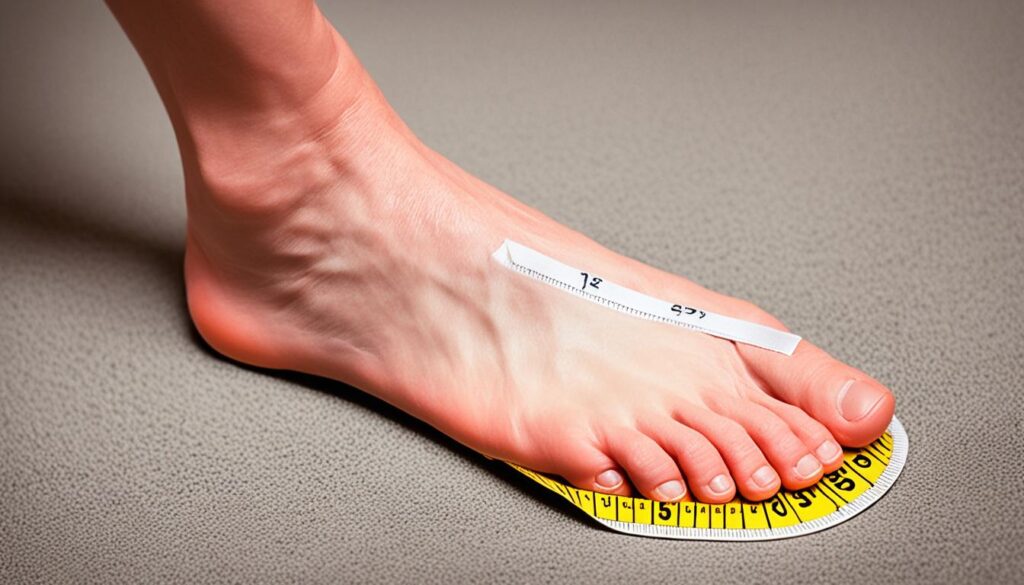
Best Insoles for Sciatica
Finding the right insoles can really help with sciatica pain. We looked at many insoles and talked to experts. Based on that, we put together a list of the best insoles for sciatica. These insoles help by giving good arch support, reducing shock, being comfortable and lasting a long time. They use top-notch materials to fight lower back and leg pain.
One top choice is the ComfortMax Flat Feet Insoles. They are great for arch support and give long-term relief from pain. The Dr. Scholl’s® Prevent Pain Insoles are also a great pick. They ease pressure on the sciatic nerve with their shock absorption and cushioning.
If comfort and support are what you need, try the WALK·HERO Insoles. They are made to improve your posture and alignment. On the other hand, the VALSOLE Support Orthotics are known for being strong and supportive. They offer great arch support for lasting pain management.
Also on our list are the CRUVHEAL Orthotic Inserts. They have premium materials, shock absorption, and let you adjust the arch support. This pair ensures a personalized fit and ultimate comfort.
These top products are perfect for those with flat feet, high arches, or ongoing back pain. They offer great quality and performance. By picking the best insoles for sciatica, you’re one step closer to reducing your pain and getting active again.
Maintaining and Replacing Insoles
It’s vital to look after your insoles and replace them on time for sciatica relief and comfy feet. Stick to simple methods to make your insoles last longer and keep your feet well-supported.
Cleaning and Caring for Insoles
Keeping your insoles clean is key to their longevity. Use mild soap and warm water to clean them. Don’t soak them. Then, let them air dry completely before reusing. Don’t use harsh chemicals or wash them in a machine; this can harm the insoles.
When to Replace Insoles
Even top-quality insoles wear out and need replacing. Look for signs like flattened cushioning and reduced support. It’s good to change your insoles every 6-12 months. If they don’t feel right, replace them sooner. Always keep an eye on how your feet feel in your shoes to know when it’s time for new insoles.
Combining Insoles with Other Sciatica Treatments
Insoles are great for easing sciatica pain but work even better with other treatments. A mix of methods boosts how well insoles work and can help you feel better for longer.
Stretching and Exercise
Adding easy stretches and exercises to your day helps a lot with sciatica. They take the pressure off your back and legs. Insoles offer extra support, making this combo a win.
Complementary Therapies
Another way to treat sciatica is through other therapies. Things like physical therapy, chiropractic care, and messages tackle the root of your pain. They also boost your overall health. These, along with insoles, form a strong team to fight sciatica and improve your life.
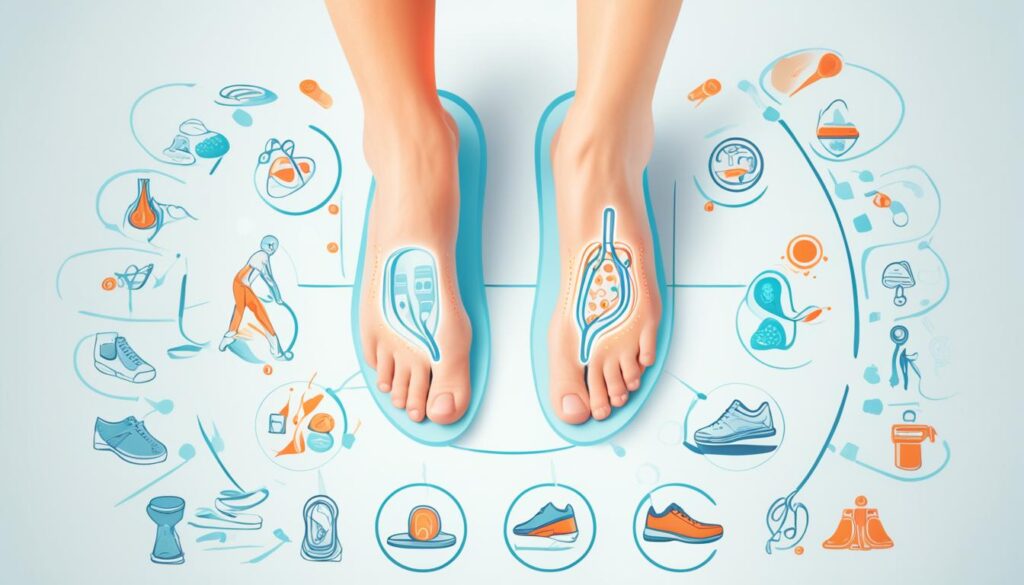
Frequently Asked Questions About Insoles for Sciatica
We often have many questions when looking for the right insoles for sciatica pain. This section will answer common questions. It will help you choose wisely and get the best from your insoles for sciatica relief.
Why is arch support important for insoles used to treat sciatica? Good arch support keeps your feet in a natural line. This lowers stress on your back and legs. With the right arch support, the sciatic nerve gets less pressure. This means less pain and better movement.
How do shock-absorbing insoles benefit individuals with sciatica? Shock-absorbing insoles lessen the stress from your feet, especially when you walk or run. They help reduce the shock that makes sciatica worse. This can lower pain and make you more comfortable.
How do I ensure a proper fit with my insoles? Getting the right size is key to getting insoles that work well. Measure your feet for the best fit. Also, wear your new insoles little by little. This lets your feet get used to the added support and comfort.
How long do insoles typically last, and how should I maintain them? Insoles usually need to be replaced every 6 to 12 months, or when they wear out. To make them last longer, clean them regularly and switch them from shoe to shoe. This helps keep them effective.
Can insoles be used in conjunction with other sciatica treatments? Yes, insoles work great with other sciatica treatments. Things like stretching, exercise, and massage can make insoles even more helpful. This full approach can offer better relief and target the reasons behind your sciatica.
| Feature | Importance for Sciatica Relief |
|---|---|
| Arch Support | Helps maintain natural foot alignment, reducing strain on the lower back and legs |
| Shock Absorption | Cushions impact, minimizing jarring effects that can exacerbate sciatica symptoms |
| Comfort and Fit | Ensures a proper, supportive fit that maximizes the benefits of the insoles |
| Lifespan and Maintenance | Proper care and timely replacement of insoles help maintain their effectiveness over time |
| Complementary Treatments | Insoles work best when used in conjunction with other sciatica management strategies |
We’ve tried to cover your main questions to clear up how insoles can help with sciatica. Keep in mind, everyone’s situation is different. Always talk to a doctor to figure out what’s best for you.
Conclusion
Finding the right insoles can change the game for those with sciatica. These insoles offer special arch support, reduce shock, and improve posture. They can ease back and leg pain. This makes you more comfortable and able to move better all day.
Insoles can also work well with other sciatica treatments like stretching and exercise. They are a key part of getting long-term pain relief and improving your life.
The ones we’ve mentioned in this guide are top choices for sciatica. They come from brands like ComfortMax and Dr. Scholl’s. Each offers unique features to help those with sciatica. Adding them to your pain management plan is a big step toward feeling better.
If you need better arch support, shock absorbance, or just feel like you’re standing better, good insoles can help a lot. It’s important to pick the right ones for you. This starts your journey to less pain and a better life quality.


